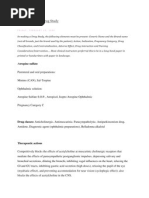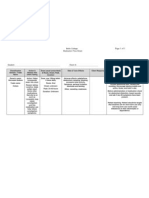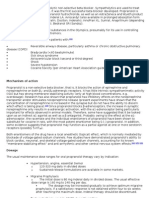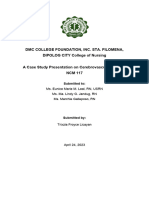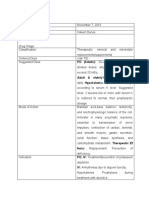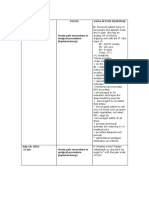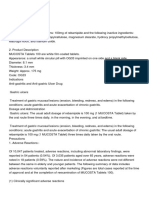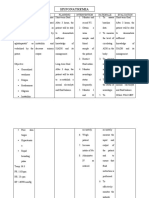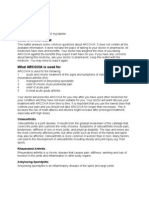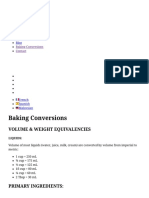Peds Concept Map
Peds Concept Map
Uploaded by
api-496323326Copyright:
Available Formats
Peds Concept Map
Peds Concept Map
Uploaded by
api-496323326Original Title
Copyright
Available Formats
Share this document
Did you find this document useful?
Is this content inappropriate?
Copyright:
Available Formats
Peds Concept Map
Peds Concept Map
Uploaded by
api-496323326Copyright:
Available Formats
1
Step 2. Support problems with clinical patient data, including abnormal physical
assessment findings, treatments, medications, and IV’s, abnormal diagnostic and lab tests, Data don’t
medical history, emotional state and pain. Also, identify key assessments that are related know where to
to the reason for health care (chief medical diagnosis/surgical procedure) and put these in put in boxes:
the central box. If you do not know what box to put data in, then put it off to the side of
the map.
#1 Key Problem/ND: Risk for #5 Key Problems/ND: Anxiety #6 Key Problem/ND: Delayed
electrolyte imbalances. - grinds teeth when anxious Growth and Development (r/t
- High fever >101 degrees F - Fidgeting Down Syndrome)
- High HR above 200 bpm in the - Given Denedryl to help fall - wears diapers at 8 years old
ED asleep - Only eats baby food
- IV therapy : 0.9% NaCl with KCl - Poor eye contact - Speaks in few words/
- Skin turgor not elastic / slow - Still posture during patient care understands a few words
- 18.8 CO2 at admission - Needs extra IV site protection
- BUN ranged from 8-21 over last or patient will pull out IV
few weeks - Needs mom’s assistance for
all daily cares
# Key Problem/ND:
# Key Problem/ND
Reason For Needing Health Care
(Medical Dx/ Surgery)
Dehydration related to gastroenteritis
Key assessments: Vital Signs, I&O, SPO2,
skin turgor and color, weight, capillary
refill, bowels sounds, lung sounds, heart
sounds
#3 Key Problem/ND: Diarrhea #2 Key Problem/ND: Nausea / #4 Key Problem/ND: Parents
- hyperactive bowel sounds on Vomiting Deficient in knowledge r/t
admission day - given Zofran 3mg IV Q8H dehydration
- Multiple occurrence at home - Multiple occurrences at home - father asked about the effects
- Created a fluid imbalance and in ED of dehydration on vital signs
- Solid foods encouraged if she - Mom explains that patient gets - Both parents would only feed
could tolerate them very upset when she vomits this child baby food
- Zofran was effective - Parents needed encouraged to
- Did not throw up once admitted give patient water frequently
- CO2 and BUN levels abnormal - Parents wanted to know the
most effective ways to battle
dehydration with out IV
therapy
2
Step 3: Draw lines between related problems. Number boxes as you prioritize problems.
LASTLY- label the problem with a nursing diagnosis.
Step 4: Identification of goals, outcomes and interventions.
Step 5: Evaluation of Outcomes
Problem # ____1___:
General Goal: maintain a normal electrolyte balance
Predicted Behavioral Outcome Objective (s): The patient will……
Have Na, K, Cl, CO2 levels in normal ranges and be free of symptoms of imbalance on the day of care.
Nursing Interventions Patient Responses
1. IV fluids 1. Labs normalized
2. Pt ate 4 tubs of baby food 2. Did not have diarrhea or vomiting
3. Administer Zofran 3. To prevent vomiting
4. Encourage fluids by mouth 4. 2oz was intake (water)
5. Monitor I&O every hour 5. I: about 10 oz, O: 1 wet diaper
6. IV assessment QH when infusing 6. Pt did well with IV assessment
7. Educate parents about condition, 7. Parents were involved and
and how to help compliant in care
8. Distraction during IV removal 8. Patient did not hyperventilate
Evaluation of outcome objectives:
Outcome met - patient was free of late imbalance symptoms and labs remained normal
Problem # ____2___:
General Goal: maintain adequate hydration
Predicted Behavioral Outcome Objective (s): The patient will……
Not vomit on the day of care.
Nursing Interventions Patient Responses
1. Administer Zofran 3mg IV Q8H 1. Did not have an increase in N/V
2. Pt comforted to prevent vomiting 2. Pt responded well to mom’s touch
3. Bland diet 3. It prevented vomiting
4. Play on iPad 4. Distracted patient
5. Using a soft and gentle tone 5. Help make pt comfortable in hospital
6. Bedrest / up as tolerated 6. Prevent pt from vomiting while up
7. Monitor I+O QH 7. Pt was compliant in staying hydrated
Evaluation of outcome objectives:
Outcome met, patient did not throw up on the day of care
3
Step 4: Identification of goals, outcomes and interventions.
Step 5: Evaluation of Outcomes
Problem # ____3___:
General Goal: Formed, solid stool
Predicted Behavioral Outcome Objective (s): The patient will…
Not have diarrhea on the day of care.
Nursing Interventions Patient Responses
1. Feed solid, low fiber diet 1. Patient only wanted baby food
2. Monitor bowel sounds 2. Normoactive bowel sounds
3. Assess abdomen 3. Pt ok with assessment when mom is present
4. Contact isolation 4. Pt did not mind.
5. Monitor I+O 5. Ate baby food and water
6. Assess skin turgor 6. Monitor for further dehydration
7. Encourage oral intake 7. Occasionally sipped when told
8. Ed. Parents on s/s of dehydration 8. Parents active in patient’s care
and late imbalances
Evaluation of outcome objectives:
Patient did not have diarrhea on day of care
Problem #4
General goal : parents will understand S/S of dehydration
Predicted Behavioral Outcome Objective (s): The parents will……
Repeat S/S of dehydration to me on the day of care.
Nursing Interventions Patient Responses
1. Ed. parents of causes of N/V/D 1. were receptive and active in education
2. Ed. about 3 severities of dehydration 2. Pt cannot understand her status d/t age
3. Answer parents questions 3. Dad understood HR can incre. w/ dehydration
4. Ed. Parents about dehydration assessment 4. Were interested in VS and skin turgor
5. Explain why I&O monitoring is important 5. They let me know everything the child ate and
how many diapers she dirtied
6. Stressed S/S of dehydration 6. Said they would return if pt became fatigued,
not eating, or drinking
4
7. Ed. Dehydration occurred due to N/V/D from 7. Parents verbally said this back to me later in
gastroenteritis day
8. Treating gastroenteritis will help prevent 8. Parents understood, stating they will finish
Further dehydration antibiotics tx
Evaluation of outcome objectives:
Parents were able to identify S/S of dehydration before they were discharged
Step 4: Identification of goals, outcomes and interventions.
Step 5: Evaluation of Outcomes
Problem # ____5___:
General Goal: decrease patient’s fear of health care professionals
Predicted Behavioral Outcome Objective (s): The patient will……
Not grind teeth and tense muscles on the day of care.
Nursing Interventions Patient Responses
1. Use positive reinforcement w/ all 1. Pt sometimes smiled back
nursing care 2. Pt was less anxious the more I talked to
2. Talk softly and kindly her
3. Talk with mom before talking with pt 3. Gained a little bit of trust from the pt
4. Do all assessments while mom is 4. Pt was least tense when mom held her
holding pt
5. Try to make distractions from IV
5. Pt likes playing on her ipad and funny
therapy noises
6. Offer pt ice cream or treat after ice- 6. Pt likes icecream, would try to behave for
cream removal ice cream
7. Soothe pt while she got her BP done. 7. Soothing worked best when coming from
8. Night nurse administered Benadryl to mom
help her fall asleep 8. Pt slept through the night
Evaluation of outcome objectives:
Outcome half met. Pt did not grind teeth but did tense muscles when she saw health care professionals.
5
Problem # ____6__:
General Goal: to help increase weight
Predicted Behavioral Outcome Objective (s): The patient will……
Eat something other than baby food on the day of care
Nursing Interventions Patient Responses
1. Encourage pt to eat solid foods 1. She was not interested
2. Ed. Parents that their child needs 2. Parent listen to me but did not act on it
more nutrients 3. Pt had trouble understanding me
3. Talk with pt with small words to 4. Baby food, jello, and ice cream were
encourage trying new foods easiest to find
4. Search unit for foods patient may like 5. Pear was pt’s favorite flavor of baby
5. Ask parents what ind of baby food food
flavors she likes 6. About 4 tubs of baby food eaten.
6. Monitor I&O 7. Patient was meeting requirements with
7. Make sure child is getting fluid oral and IV intake
requirements
Evaluation of outcomes : outcome not
met. Pt only ate baby food and parents
would not encourage her to eat anything
else.
You might also like
- Mind Games - Nora RobertsDocument442 pagesMind Games - Nora Robertsdanniellshinraq100% (1)
- Case Study 2Document7 pagesCase Study 2desdav100% (1)
- Cover Letter and Progress ReportDocument4 pagesCover Letter and Progress Reporti love chubz100% (1)
- Case StudyDocument49 pagesCase StudyLennie Marie B Pelaez100% (1)
- Drug Study PneumoniaDocument2 pagesDrug Study Pneumoniamadelaine_espirituNo ratings yet
- Drug Name Dosa Ge Mechanis Mof Action Indicatio N Contraindic Ation Adverse/Side Effects Nursing InterventionsDocument14 pagesDrug Name Dosa Ge Mechanis Mof Action Indicatio N Contraindic Ation Adverse/Side Effects Nursing InterventionsVin LandichoNo ratings yet
- Drug Study Ready TEMPLATEDocument1 pageDrug Study Ready TEMPLATECezanne CruzNo ratings yet
- Hypokalemia Periodic ParalysisDocument14 pagesHypokalemia Periodic ParalysisJennirose JingNo ratings yet
- Case 4 - Diagnostic and Laboratory ProceduresDocument7 pagesCase 4 - Diagnostic and Laboratory ProceduresChristine Pialan SalimbagatNo ratings yet
- Miglitol (Glyset)Document1 pageMiglitol (Glyset)ENo ratings yet
- ETOPOSIDEDocument4 pagesETOPOSIDEkajal guptaNo ratings yet
- GordonDocument6 pagesGordonKristine Joy EbordeNo ratings yet
- Name of Drug Dosage, Route, Frequency and Timing Mechanism of Action Indication Adverse Reactions Special Precautions Nursing ResponsibilitiesDocument2 pagesName of Drug Dosage, Route, Frequency and Timing Mechanism of Action Indication Adverse Reactions Special Precautions Nursing ResponsibilitiesIvan Matthew SuperioNo ratings yet
- Im Case Study 04Document49 pagesIm Case Study 04Shaine BalverdeNo ratings yet
- NifedipineDocument3 pagesNifedipineNovi YulianaNo ratings yet
- GitDocument302 pagesGitjgcriste100% (7)
- TRAMADOLDocument4 pagesTRAMADOLRudie Lee PascualNo ratings yet
- Case AnalysisDocument25 pagesCase AnalysisGerly LagutingNo ratings yet
- Trifluridine and TipiracilDocument3 pagesTrifluridine and TipiracilKristine AcasioNo ratings yet
- JM Drug Study CaseDocument4 pagesJM Drug Study CaseMilky Lescano LargozaNo ratings yet
- AmbroxolDocument4 pagesAmbroxoldiannuryandaNo ratings yet
- RLE314 CU4 MedicationDocument7 pagesRLE314 CU4 MedicationVAL ASHLIE ACEBARNo ratings yet
- Drug Study (Burn Injury) ManuscriptDocument4 pagesDrug Study (Burn Injury) ManuscriptEricka VillanuevaNo ratings yet
- NCP MeningitisDocument2 pagesNCP MeningitisARISNo ratings yet
- Atropine Sulfate Drug StudyDocument4 pagesAtropine Sulfate Drug Studysandal_meenuNo ratings yet
- Docusate Sodium ColaceDocument1 pageDocusate Sodium ColaceAmanda CoadNo ratings yet
- PropranololDocument6 pagesPropranololanon_678895677No ratings yet
- Nursing Care PlanDocument13 pagesNursing Care Planyumiko0% (1)
- Case Pres Cerebrovascular DiseaseDocument34 pagesCase Pres Cerebrovascular DiseaseADRIATICO JAROSLUVNo ratings yet
- Urinalysis: PurposeDocument6 pagesUrinalysis: PurposebobtagubaNo ratings yet
- Case Study FrontpageDocument6 pagesCase Study FrontpageTom-tom LunaNo ratings yet
- Pleural Effusion Case StudyDocument5 pagesPleural Effusion Case Studyjanice ianNo ratings yet
- Galantine HBRDocument5 pagesGalantine HBRArone SebastianNo ratings yet
- Drug StudyDocument33 pagesDrug Studyjefwy8No ratings yet
- Diverticular DiseaseDocument8 pagesDiverticular Diseasenurse_enzo100% (1)
- NCP FinalDocument18 pagesNCP FinalHelen GonzalesNo ratings yet
- Guaifenesin Drug CardDocument1 pageGuaifenesin Drug CardJessie JenningsNo ratings yet
- Fluid Volume Deficit Related To Active Fluid Volume LossDocument3 pagesFluid Volume Deficit Related To Active Fluid Volume LossMelDred Cajes BolandoNo ratings yet
- Discharge PlanDocument1 pageDischarge PlanJullie Anne SantoyoNo ratings yet
- Vincristine (OncovinDocument4 pagesVincristine (Oncovin9959101161No ratings yet
- NCPDocument13 pagesNCPÍam KristineNo ratings yet
- Week 3. COURSE TASK - Acute PancreatitisDocument3 pagesWeek 3. COURSE TASK - Acute PancreatitisqwertNo ratings yet
- Right Sided Heart FailureDocument18 pagesRight Sided Heart FailureShaf Abubakar100% (1)
- FDARDocument1 pageFDARJoan QuebalayanNo ratings yet
- Nursing Care PlanDocument3 pagesNursing Care PlanMae Therese AlabotNo ratings yet
- Drug Study of EpinephrineDocument3 pagesDrug Study of EpinephrineChristina mikaela CabusaoNo ratings yet
- Febrile SeizuresDocument24 pagesFebrile SeizuresShrikant Hemant JoshiNo ratings yet
- Name Mucosta Tablets 100 Description PDFDocument7 pagesName Mucosta Tablets 100 Description PDFnanda RaharjaNo ratings yet
- Tube FeedingDocument47 pagesTube FeedingArlyn Mendenilla0% (1)
- Omeprazole Drug StudyDocument4 pagesOmeprazole Drug StudyFeliza Therese A. DeloriaNo ratings yet
- Case 1 - Pneumonia (Final)Document4 pagesCase 1 - Pneumonia (Final)Joegie ArioNo ratings yet
- HYPONATREMIADocument3 pagesHYPONATREMIADienizs Labini TadenaNo ratings yet
- Drug Study HydrocodoneDocument1 pageDrug Study HydrocodoneYlrenne DyNo ratings yet
- Nursing Care PlanDocument8 pagesNursing Care PlanKing RamosNo ratings yet
- Omeprazole DSDocument2 pagesOmeprazole DSjenniferducaoNo ratings yet
- Subjective: "Sumikip Ang Dibdib Ko at Hindi Ako Makahinga NG Maayos" As IndependentDocument2 pagesSubjective: "Sumikip Ang Dibdib Ko at Hindi Ako Makahinga NG Maayos" As IndependentCorinneNo ratings yet
- Assessment Nursing Diagnosis Objective of Care Intervention RationaleDocument2 pagesAssessment Nursing Diagnosis Objective of Care Intervention Rationaleahmad ryanNo ratings yet
- Assessment Healt H Patte RN Nursing Diagnosis Desired Outcome (Edit) Intervention (Edit) Evaluation (EDIT) Rema RKSDocument3 pagesAssessment Healt H Patte RN Nursing Diagnosis Desired Outcome (Edit) Intervention (Edit) Evaluation (EDIT) Rema RKStflorenzNo ratings yet
- ARCOXIADocument22 pagesARCOXIATeresa JunioNo ratings yet
- Ventricular Septal Defect, A Simple Guide To The Condition, Treatment And Related ConditionsFrom EverandVentricular Septal Defect, A Simple Guide To The Condition, Treatment And Related ConditionsNo ratings yet
- A Simple Guide to Pseudohypoparathyroidism, Diagnosis, Treatment and Related ConditionsFrom EverandA Simple Guide to Pseudohypoparathyroidism, Diagnosis, Treatment and Related ConditionsNo ratings yet
- Nursing Care Plan For Imbalanced Nutrition Less Than Body Req NCPDocument3 pagesNursing Care Plan For Imbalanced Nutrition Less Than Body Req NCPHERLIN HOBAYANNo ratings yet
- Baking Conversions - Anna OlsonDocument4 pagesBaking Conversions - Anna Olsonseo eun gi100% (1)
- Catering ManagementDocument5 pagesCatering ManagementWc-mark ChuvachucHuNo ratings yet
- The Easter Story QuizDocument5 pagesThe Easter Story QuizThaysa FoxNo ratings yet
- Exercises On ColonDocument4 pagesExercises On Colonmf9295533No ratings yet
- 0995 DUK - MealPlanner 1500 Veggie B 11 - 3 - 21Document2 pages0995 DUK - MealPlanner 1500 Veggie B 11 - 3 - 21PRAVASH KUMAR SINGHNo ratings yet
- SUMMATIVE TEST 3 (UNION AND INTERSECTION OF EVENTS) Students Copy PPTXDocument66 pagesSUMMATIVE TEST 3 (UNION AND INTERSECTION OF EVENTS) Students Copy PPTXEL JA NE ReyNo ratings yet
- Berserk of Gluttony Vol. 5Document231 pagesBerserk of Gluttony Vol. 5Amon100% (1)
- ProteinDocument32 pagesProteinYo1No ratings yet
- Things Fall ApartDocument6 pagesThings Fall ApartArfie MenesterioNo ratings yet
- ENHELW - 10D7N Winter Adventure in Finland + Norway King Crab Safari - 6ppDocument6 pagesENHELW - 10D7N Winter Adventure in Finland + Norway King Crab Safari - 6ppSolid Travel ReservationNo ratings yet
- YARR PreviewDocument19 pagesYARR PreviewRocco QuattrocchiNo ratings yet
- Patient Information Booklet 20141Document28 pagesPatient Information Booklet 20141shahidashraftNo ratings yet
- Past Perfect - Past Simple - Present PerfectDocument1 pagePast Perfect - Past Simple - Present PerfectThuy DuongNo ratings yet
- Dietary Needs - Worksheet - IntermediateDocument6 pagesDietary Needs - Worksheet - IntermediateSorana PaleuNo ratings yet
- Autonomous Motivation and Fruit-Vegetable Intake in Parent-Adolescent Dyads - Dwyer Et Al (2017)Document9 pagesAutonomous Motivation and Fruit-Vegetable Intake in Parent-Adolescent Dyads - Dwyer Et Al (2017)eaguirredNo ratings yet
- English TestDocument11 pagesEnglish TestNadezhdaNo ratings yet
- Amora Palace Hotel & Restaurant: Banquet Event OrderDocument2 pagesAmora Palace Hotel & Restaurant: Banquet Event OrderSheena HarrienNo ratings yet
- Study of Amount of Casein in Different Samples of MilkDocument9 pagesStudy of Amount of Casein in Different Samples of MilkPratyush Sharma80% (79)
- Review 1Document18 pagesReview 1Pham Thi Nhu QuynhNo ratings yet
- lop11deso01Document7 pageslop11deso0110.Trần Thị Thu Hường Lớp 8A5No ratings yet
- Eng Worksheet 4Document2 pagesEng Worksheet 4Paramita BanerjeeNo ratings yet
- Harlan 2021Document8 pagesHarlan 2021allyvdimaandalNo ratings yet
- She Has Danced in The Carnival: He Has Travelled To Most Parts of The WorldDocument7 pagesShe Has Danced in The Carnival: He Has Travelled To Most Parts of The WorldGustavo AliagaNo ratings yet
- SA Tool - SITXINV006Document36 pagesSA Tool - SITXINV006jagvirNo ratings yet
- HTĐ Vs QKĐDocument8 pagesHTĐ Vs QKĐ25. Phạm Thị MinhNo ratings yet
- NewEngAdults2 - Test6 - SolucionesDocument1 pageNewEngAdults2 - Test6 - SolucionesSol SánchezNo ratings yet
- 30 Must-Read Bestsellers in Infographics by HeadwayDocument2 pages30 Must-Read Bestsellers in Infographics by HeadwayChitra GoliyaNo ratings yet
























